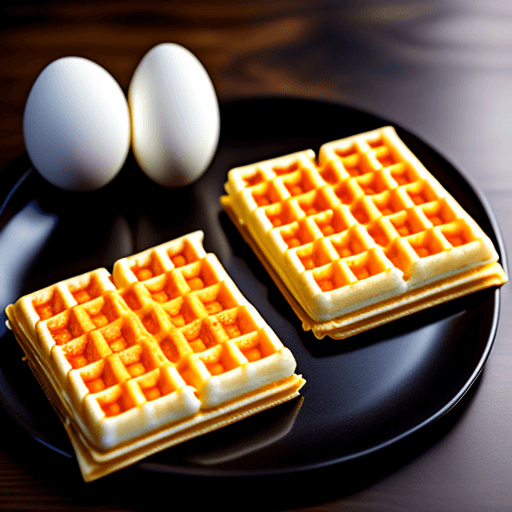I always used all-purpose or almond flour to make my waffles because they were the most popular flours with my friends. However, I recently starting using Buckwheat flour instead and I am glad I made this switch because it has a lot more protein and fiber than the flours I used to use. I understand that Buckwheat flour is not something that you hear very much about when it comes to waffles. However, that does not mean that there are no other flours that will make your waffles nutritious and delicious. The rest of this article will tell you why I think you should use Buckwheat flour the next time you want to make waffles.
Buckwheat flour is a gluten-free grain that is high in fiber, magnesium, potassium, and niacin (vitamin B3). Buckwheat is a source of complete proteins, which means it contains all eight essential amino acids. One cup (168 grams) of buckwheat contains 6 grams of protein.
Buckwheat flour has a higher protein and fiber content than all-purpose and whole wheat flours so it will make your waffles more nutritious. Some people swear by the benefits of buckwheat flour waffles, claiming that it is easier to digest and provides a more satisfying breakfast or snack.
If you want to make thin waffles with Buckwheat flour instead of all-purpose flour, then I recommend that you read this article so that you choose the right thin waffle maker to use: https://wafflemakercenter.com/best-thin-waffle-makers-for-classic-waffles/.
If you want to buy a waffle maker with removable plates because you want an easier time cleaning up afterward, then I recommend that you read this article: https://wafflemakercenter.com/best-waffle-makers-with-removable-plates/.
Table of Contents
What is Buckwheat?
Although the word ‘wheat’ is in the name ‘Buckwheat’, buckwheat does not contain any wheat so it is safe for anyone who is gluten intolerant. It is a seed of a fruit that is related to rhubarb but it is used like a grain because it is processed into groats, flour, and noodles.
Buckwheat is a shrub-like plant with broad heart-shaped leaves that is indigenous to the temperate climates of East Asia and first cultivated in China around 1000 AD.
There are over 14 species of the Buckwheat plant currently grown all over the world, two of which are grown on land and the rest of which are found in the wild with the majority of them being grown in China, Japan, and North America.
Nutritional Value
Listed below is the nutritional information about buckwheat:
• The copper, zinc, and manganese levels in Buckwheat are higher than those found in other cereal grains. Buckwheat is also a healthy addition to any diet because copper, zinc, and potassium are easily absorbed and used by your body. Buckwheat also contains no gluten, so persons with gluten sensitivity or intolerance can eat pure buckwheat flour, groats, and grits without worry.
• Buckwheat has a higher protein level than oats and its proteins are complete because each consists of all eight essential amino acids, including lysine which makes up 6% of its nutritional profile, histidine, isoleucine, leucine, methionine, phenylalanine, threonine, tryptophan, and valine.
The human body cannot make essential amino acids, so you will have to get them by adding them to your meals.
• Buckwheat grains are abundant in soluble and insoluble fiber, both of which aid digestion and make it easier to pass stools.
• Buckwheat is also gluten-free, making it a good option for those with celiac disease or gluten intolerance.
Health Advantages
Listed below are the benefits of adding buckwheat to your diet:
• Diabetics will benefit greatly if they add more buckwheat to their diet. Buckwheat has high levels of fiber content that inhibits glucose absorption in their bloodstream, which keeps the blood sugar at healthy levels and reduces your A1C.
• It aids in the immune system’s function. IF you want to keep your immune system strong, you will need high levels of copper, zinc, and potassium. Copper will also aid in the creation of red blood cells.
• It promotes cardiovascular health. Buckwheat’s magnesium concentration aids in decreasing blood pressure and maintaining healthy cholesterol levels.
• Buckwheat fights inflammation, which is a sign of many systemic disorders. Buckwheat polyphenols, which are water-soluble plant pigments with antioxidant characteristics, help to reduce inflammation and blood vessel clotting.
Procurement and Preparation
The plant’s seeds are gathered and processed in a number of ways so that they may be used for a variety of purposes. Once the husk is removed, the three-sided triangle-shaped seeds can be added to cereals, finely ground into flour, roughly processed into grits, or roasted to form kasha.
Boiling, steaming, and baking are some of the ways to prepare buckwheat groats and kasha. The dishes fulfill the same purpose as potatoes or rice in a meal. Also the addition of buckwheat flour can add thickness and color to sauces and gravies.
Buckwheat can also be used for:
• Providing nectar to honey bees, which they convert into a dark, strong-flavored honey
• An ingredient in cattle feed that can be used with corn (maize), barley, or oats.
• As a weed-prevention cover crop before planting another crop
• As a fertilizer crop that will be plowed under before the following planting to return nutrients and moisture to the soil.
Buckwheat is a plant that is both versatile and nourishing. This gluten-free, nutrient-dense vegetable grows swiftly, providing a steady supply of nourishment. Some people develop a skin rash after eating buckwheat, so keep an eye out for signs of allergies.
Buckwheat is readily accessible and may be used in a broad range of dishes, including morning cereal, porridge pancakes, grain salads, Asian Soba noodles, and baked products.
The taste of buckwheat can be too strong or bitter for some people, in which case, they should be combined with rice, millet, barley, oats, or farro.


